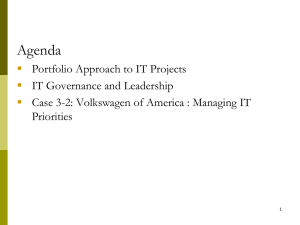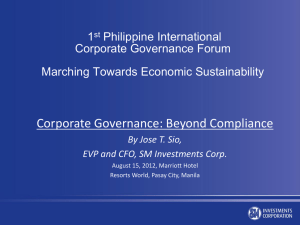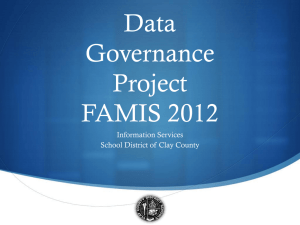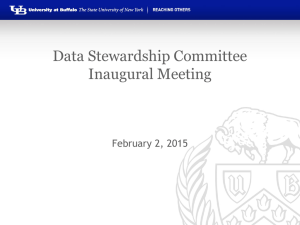Program governance structure setup
advertisement
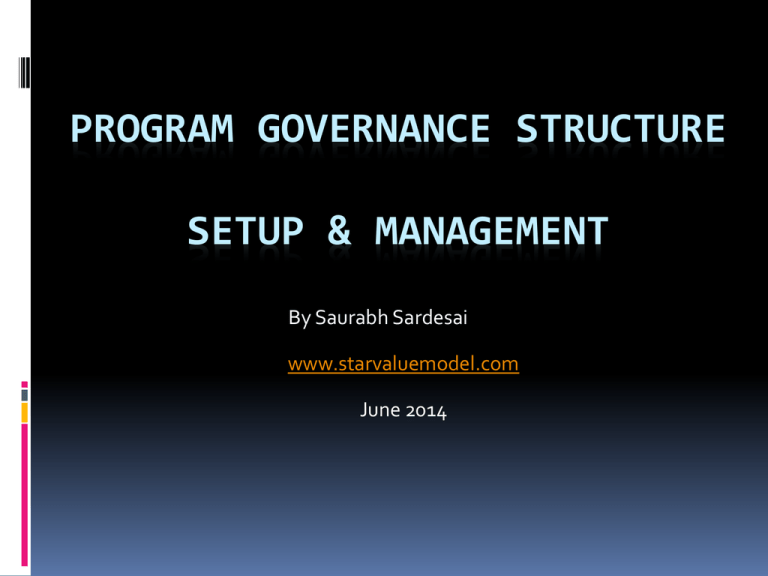
PROGRAM GOVERNANCE STRUCTURE SETUP & MANAGEMENT By Saurabh Sardesai www.starvaluemodel.com June 2014 Objectives Establish a Program/Project governance structure within the organization and ensure stakeholder participation Define the program roles, decision making hierarchy, program execution strategies and best practices Describe the protocol for proper flow of relevant information to all stakeholders Establish a project/program review, issue management & change mgmt mechanism Mechanism to identify program compliance and communications to all stakeholders Evaluate various models of program governance and investigate their suitability for adaption Translate business strategy into actual program execution via a proper governance framework Governance defined Governance, for a program or a project, is a combination of individuals filling executive and management roles, program oversight functions organized into structures, and policies that define management principles and decision making. This combination is focused upon providing direction and oversight, which guide the achievement of the needed business outcome from the execution of the program effort, and providing data and feedback, which measure the ongoing contribution by the program to needed results within the overall business strategy and direction. Need/Background The organization was facing a huge problem of managing diverse projects across geographies without having a formal program structure in place Senior management was finding it increasingly difficult to have an oversight on project execution in absence of proper governance structure and formal feedback channels There was a clear disconnect between project execution and business mission or strategy There was no overarching body like a Steering committee to provide oversight to projects A need was felt to aggregate all multiple projects data in a central place and use the information to better manage the defined outcomes Stakeholders Board of Directors and C level executives Project sponsors and funding partners Internal and external clients of the organization Business units within the organization Vendor partners of the organization Project managers and delivery managers/heads Development teams, architects and testers Support staff, line managers and consultants Product control and management teams Other relevant project stakeholders Plan of action Initiate consultations with relevant stakeholders to get their opinion & feedback Establish a Program Steering Committee as the overarching body for program/project execution Establish a Program Management Office (PMO) Establish a Program Organization model and Project Organization model Define and set up roles for Program Director, Program Managers, PMO managers and PMO support staff Implement mechanisms to provide guidance and direction regarding policies, governance principles, and decision or authority specifications. Establish a communications network and protocol for effective program and project communication to internal and external stakeholders of the organization Steering committee models Consensus Model: Executive-level sponsors who must reach consensus on issues, changes, and adjustments in order to proceed Consultative Model: Executives and senior managers who are stakeholders for some aspect of the defined outcomes. Their role is to understand issues and needed changes, provide advice and assessment of potential impact, and make needed adjustments within their own responsibility area Advisory Model: Representatives for the major business segments who are responsible for outcomes, or portions of outcomes, within the business strategy and direction. Their role is to monitor program progress, understand issues raised and adjustments made, assess potential impact within their own business segments, and carry back information about committee decisions to their respective business segments For our initiative we recommend the Advisory model as the organization is large and has many interdependent businesses that routinely interact with each other Recommended model – Program Management Office (PMO) The Program Management Office (PMO) provides support along administrative, financial, process, and staff dimensions associated with successful program execution. The PMO also provides review and tracking of financial expenditures, generation of required reports and financial documents, and ensures compliance with policies and practices. The PMO provides & administers policies, procedures, & practices that provide an operational framework for program members Sample Program model Sample PMO structure Sample Project structure within a PMO Benefits of recommended model Increases the long term potential of the program and individual projects Continuous linkage to enterprise business strategy and direction Clear and well-understood decision-making authority Effective oversight of & insight into program progress and direction Executive control over program evolution and outcomes Central storage and management of all project data Measuring Program success Delivering the program to the client on time and within the dates specified in the agreement, taking into account any amendments or approved change requests Achieving the financial objectives set forth in the business case, taking into account any amendments or change controls Meeting all expectations related to quality and fulfilment of program requirements Adhering to an established program methodology measured by a joint governance board Achieving overall client satisfaction and repeat business PMO – Tools of engagement Overview and statement of purpose Communication plan Integrated program schedule Program quality plan Program risk management plan Program issue management plan Program change management Program monitoring and control management Elements of good program governance A compelling business case, stating the objects of the project and specifying the in-scope and out-of-scope aspects A mechanism to assess the compliance of the completed project to its original objectives Identifying all stakeholders with an interest in the project A defined method of communication to each stakeholder A set of business-level requirements as agreed by all stakeholders An agreed specification for the project deliverables The appointment of a project manager Clear assignment of project roles and responsibilities Elements of good program governance….contd. A current, published project plan that spans all project stages from project initiation through development to the transition to operations. A system of accurate upward status- and progressreporting including time records. A central document repository for the project A centrally-held glossary of project terms A process for the management and resolution of issues that arise during the project A process for the recording and communication of risks identified during the project A standard for quality review of the key governance documents and of the project deliverables Program Communications Plan Sets up approved methods of communication Establishes standard communication procedure Frequency and type of updates provided to the program/project stakeholders Provides consistency in information flow Removes misinterpretations and doubts What information to be sent to whom & when Ensures Executive program engagement Helps keep everyone on the same page Communication Plan elements Documented communication paths for information sharing, including tools (VOIP, email, video/Web conferencing, etc.) will be used throughout the program & for projects Program and project contact lists based Roles and responsibilities matrix for all stakeholders A program organization chart to identify high-level organization, reporting, escalation and accountability for the program. Approval and escalation procedures for decision making Recurring Communication Matrix to ensure timely and effective communication Program event management plan that ensures the right event occurrence reporting about issues, risks, milestones etc Integrated Program Schedule Key program tasks Key program and/or project milestones Duration of the program and projects in it Dependencies related to the program Assigned responsibilities within the program Key deliverables of the program & schedule Program tracking and control mechanism Actual v/s Expected program metrics Measurement and analysis of any deviations Program Quality Plan The quality plan defines the expectations of quality that will be delivered by the program. The plan addresses the overall approach that will be adopted by the program and associated projects to ensure that quality is delivered according to stakeholder expectations. The quality plan also defines quantitative measures that are used to validate quality prior to moving through a quality gate and eventually prior to implementation. Program Risk Management Plan The risk management plan is used to define the tolerance for risk throughout the program life cycle as well as the methods for identifying, recording and addressing risk throughout the program. The early and frequent identification of risk in a program is essential to meeting cost, schedule and quality expectations. Steering committee and program manager to meet on a monthly basis, or as defined in the communication plan, to review the identified risks, examine each associated action plan and define updates that need to be initiated. Additionally, the team communicates any newly identified risks that may impact the program as they surface. Sample program risk distribution chart 13% 14% Dependencies Requirements 12% 20% 2% Knowledge Availability Commitment 6% 33% Project size Complexity Program Mgr v/s Project Mgr Program manager Project manager Integrates efforts, continuously assesses and refines approaches and plans, ensures good communication. Plans, organizes, directs, and controls the project effort. Directs managers to achieve defined outcomes aligned with business strategy. Manages for on-time delivery of specific products. Acts as the implementation arm of the program sponsor(s) and / or steering committee. Manages work within the project plan framework. Manages managers. Manages technical staff. As Table above shows, the program manager and project manager roles are quite different from one another. Whereas project managers typically focus on delivering a specific component, program managers typically focus on one or more outcomes that are business strategy components. Links to Business Strategy Throughout program planning and execution, managers must ensure that the program sustains a connection to the business strategy. This strategy is dynamic, not static. Both internal and external events affect the enterprise's initiatives, So programs need mechanisms that will maintain a link between the initiative and the business strategy, and provide for effective data exchange and necessary adjustments. We can divide such mechanisms into two categories: those active during program mobilization and planning, and those active during execution. Program Mobilization – Strategic Review IT goals and strategy Program capital and expenses budget Program benefits definition Program outline Candidate projects identification Program mobilization plan Consulting and staffing agreements A business strategy review Program planning strategy Program execution reviews As the program proceeds, the program plan and schedule should provide for periodic strategy reviews by the program sponsor(s) and / or steering committee. The schedule for these reviews can be aligned with the program's phase structure, which cuts across all of the constituent projects. As a phase-end approaches, reviewers can compare the program's current state and results against the then-current business strategy, and propose needed adjustments. Decisions and Authority An important aspect of program governance is assigning specific decision-making authority to each executive and management role. Program managers can hold special group work sessions for this purpose and then create and distribute a matrix for major decision areas and roles. Decision hierarchy structure should be clearly communicated to all program stakeholders Sample authority matrix Program Issue Management Plan Throughout any program, risks are bound to become issues needing resolution in accordance with the strategy defined in the risk management plan. In the likely scenario that an issue arises that has not yet been identified as a risk, the issue management plan provides strategies and guiding principles for resolving the issue. Recognizing that this theoretical situation is not the typical situation in the execution of programs and projects, the same escalation principles identified through the program organization chart apply in the escalation of issues. Program Change Management Whether due to missed requirements, project issues or increased scope, a program is bound to encounter change during the life cycle. The program change management plan defines the authority that the program has to approve change from an associated project, how said project requests change the agreed-to plan How the program should receive approval on change requests that are beyond its authority is also defined in this plan Program monitoring & control Event log (includes identified risks, issues, changes, decisions and action items) Project performance information such as key metrics on realized rate, resource utilization, ROI, duration, deliverables etc Weekly status reports to stakeholders Recommendations for intervention and corrective actions from senior management Lessons learnt activities from closed initiatives Managing change control requests Effectively manage deviations from baseline Conclusion Establishing a governance framework is a significant activity requiring participation from all the relevant stakeholders The key to a program’s success is optimal utilization of the governance framework, policies and best practices Continuous feedback and communication are the essential ingredients of a Program Program Management is a ‘people’ thing’ and must be projected that way Thank you
